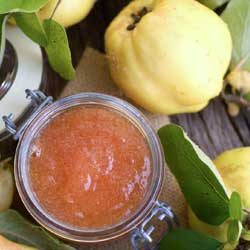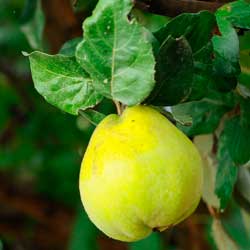Don’t confuse this quince with the “flowering quince.” Although beautiful, it’s not edible. However, the heralded quince is both edible and beautiful!
Why is quince the fruit of the year?
Well, the quince has a noble history. Ancient Greek brides used it as a breath freshener. Paris awarded Aphrodite an “apple” (actually a quince) and started the Trojan Wars. Even the Roman cookbook “Apicious” included quince recipes.
Nowadays, though, many folks know nothing about quince. It’s time to change that.
Growing a fruiting quince tree is easy, the difficulty may be choosing the best variety if your garden center offers a wide selection. Check the tags for future size as varieties slowly grow from 10′ to 26′ tall; however, a new variety ‘Patio’ remains small enough to plant in a container. Most are self-pollinating, although some varieties will have improved production if another variety is available for cross-pollination. Be sure and ask about this if you’re concerned about the amount of fruit.
Site the tree in a well draining location where it will receive full sun. Espalier against a south-facing wall if your garden is small. After establishment, consider it “drought tolerant.” Fertilize in late fall and spring with a low nitrogen fertilizer. Prune in early spring to remove dead, diseased and crossing branches. Also, remove branches growing towards the center of the tree to keep the center open for air and light. Trim any low thorns that are inconvenient. Flowers and fruits appear on the new growth.
In the winter, twisted branches provide architectural structure in the garden. In spring, dark green oval leaves with fuzzy white undersides appear, followed In June by 2″ light pink or white flowers. The fragrance of the developing yellow 3-4″ diameter fruits makes a person’s mouth water. Although it’s tempting to harvest, let the fruits remain on the tree as long as possible to maximize the flavor. Remove the fruit by cutting it off before the first frost.
Unfortunately, most quince varieties are too tart to eat without cooking. Solve this challenge and utilize the high pectin content by cooking in jams, jellies or candies. For a new twist on your regular apple pie or crisp, replace half of the apples with quince. On the other hand, try it peeled and roasted, baked or stewed. Be adventurous and try a new ethnic recipe. Many include quince to combine the tartness of the quince and counteract the oily taste of meats. Persian recipes, especially, have a long history of meat and quince stews.
Hail to the Quince!



